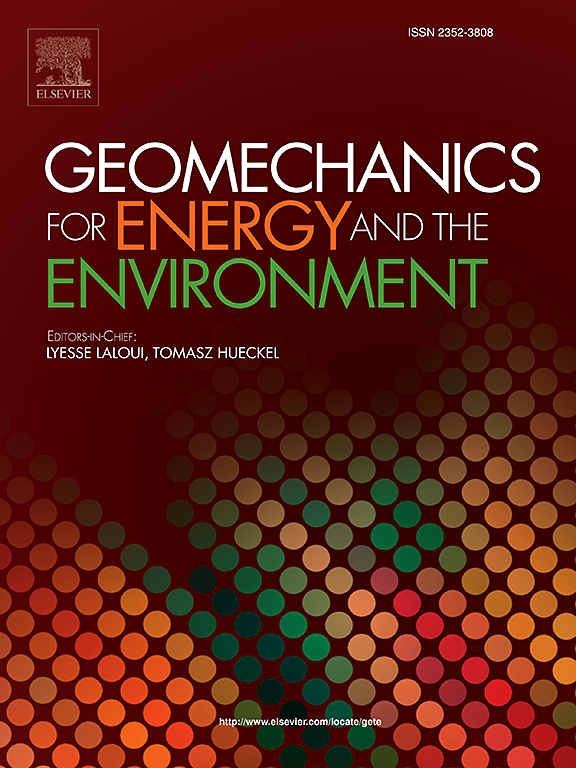Modelling flow and transport in fractured crystalline rocks by an upscaled equivalent continuous porous media method
IF 3.3
2区 工程技术
Q3 ENERGY & FUELS
引用次数: 0
Abstract
Deep geological disposal of radioactive waste in sparsely fractured crystalline rocks is being considered by several countries. With a thorough delineation of the faults and fractures, it is feasible to develop a hydrogeological model for assessment of flow and transport in the fractures. For this purpose, we developed workflow and numerical models for fractured crystalline rocks by an upscaled equivalent continuous porous media (ECPM) approach. This method is independent of the influences from equivalent thickness of fracture, the meshing size, and the alignment between mesh and fracture. The methodology was first verified by modelling the flow and transport in a single fracture and compared with the analytical solutions. The ECPM model was then benchmarked with a series of test cases containing 4 connected deterministic fractures, with consistent comparison with the results of other modelling teams using different approaches. It was eventually implemented for the generic reference case that investigated the KBS-3V concept of waste disposal. We implemented a two-step multiscale modelling method to overcome the challenge of immense hardware demand resulted from simulating small scale engineered barrier systems (EBS) in a large-scale field model. Our modelling results for the generic reference case are comparable to those of peer international teams participating in the DECOVALEX2023 TaskF1. It also highlighted the significance of engineered barriers to containing radionuclide tracers in the repository.
用升级等效连续多孔介质方法模拟裂隙结晶岩的流动和输运
若干国家正在考虑在裂隙稀疏的结晶岩中进行放射性废物的深层地质处置。随着断层和裂缝的全面圈定,建立裂缝中流动和输运的水文地质模型是可行的。为此,我们采用升级等效连续多孔介质(ECPM)方法开发了裂隙结晶岩的工作流程和数值模型。该方法不受裂缝等效厚度、网格尺寸、网格与裂缝对齐等因素的影响。该方法首先通过模拟单个裂缝中的流动和输运来验证,并与解析解进行了比较。然后,将ECPM模型与包含4个连接的确定性裂缝的一系列测试用例进行基准测试,并与使用不同方法的其他建模团队的结果进行一致的比较。它最终被用于调查KBS-3V废物处置概念的通用参考案例。我们实施了一种两步多尺度建模方法,以克服在大规模现场模型中模拟小规模工程屏障系统(EBS)所带来的巨大硬件需求的挑战。我们对一般参考案例的建模结果与参加DECOVALEX2023 TaskF1的同行国际团队的结果相当。它还强调了工程屏障对储存库中放射性核素示踪剂的重要性。
本文章由计算机程序翻译,如有差异,请以英文原文为准。
求助全文
约1分钟内获得全文
求助全文
来源期刊

Geomechanics for Energy and the Environment
Earth and Planetary Sciences-Geotechnical Engineering and Engineering Geology
CiteScore
5.90
自引率
11.80%
发文量
87
期刊介绍:
The aim of the Journal is to publish research results of the highest quality and of lasting importance on the subject of geomechanics, with the focus on applications to geological energy production and storage, and the interaction of soils and rocks with the natural and engineered environment. Special attention is given to concepts and developments of new energy geotechnologies that comprise intrinsic mechanisms protecting the environment against a potential engineering induced damage, hence warranting sustainable usage of energy resources.
The scope of the journal is broad, including fundamental concepts in geomechanics and mechanics of porous media, the experiments and analysis of novel phenomena and applications. Of special interest are issues resulting from coupling of particular physics, chemistry and biology of external forcings, as well as of pore fluid/gas and minerals to the solid mechanics of the medium skeleton and pore fluid mechanics. The multi-scale and inter-scale interactions between the phenomena and the behavior representations are also of particular interest. Contributions to general theoretical approach to these issues, but of potential reference to geomechanics in its context of energy and the environment are also most welcome.
 求助内容:
求助内容: 应助结果提醒方式:
应助结果提醒方式:


